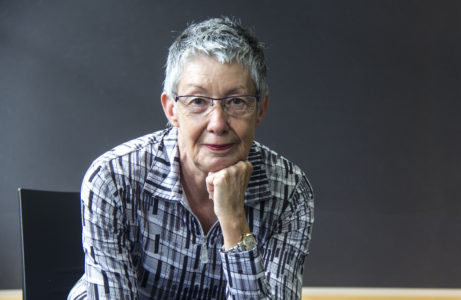Making Pedagogic Sense of Design Thinking: Author Interview

As part of the 2019 special issue ‘Design Thinking for Education’ in the DeGruyter open access journal ‘Open Education Studies’ the author quartet Gnanaharsha Beligatamulla, Janice Rieger, Jill Franz, and Megan Strickfaden present a qualitative study investigating educators experience of design thinking pedagogy in the higher education context. Design thinking is a concept within education that has been discussed in the academic spheres for more than 30 years, and has recently become popular in academic research and practice. It is not only important to conduct research on the students’ experiences of design thinking, but also the educators’ experience. In the interview, they talk about open access, the implications of their research, and their experiences using design thinking.
Your article ‘Making Pedagogic Sense of Design Thinking in the Higher Education Context’ is part of the topical issue ‘Design Thinking for Education’. Do you remember how you first learned about the topical issue?
Gnanaharsha: When we were ready to publish our findings, I started looking for a journal which specifically discusses design thinking education. While browsing through online databases and search engines, I found the call for this topical issue. It was very timely and relevant. So, it was easier for us to decide to submit our paper, especially with Open Access.
Did Open Access play a role in your decision to submit?
Gnanaharsha: Exactly! A few weeks before this decision, we celebrated Open Access Week with our library at QUT. My promise was to publish my next paper with an Open Access journal -so here we go. Further, I want to take this opportunity to thank the topical issue team and the publisher. It was a smooth journey with the help of the Managing Editor, Beata Socha and the Editor, Stefanie Panke at Open Education Studies. Also, I reviewed a paper for the Open Education Studies. I believe this kind of free services will shape the future of scholarly knowledge dissemination.
Janice: It is becoming increasingly important to provide access to a wider audience, and Open Access facilitates this. Ethically it is important to share our funded research through Open Access.
Megan: Yes, I appreciate open access and believe it is the future of publications.
What are the implications of the themes that emerged from your interview study?
Jill: An unexpected outcome of the study was the emergence of a single super-ordinate theme suggesting that while people can make sense of a phenomenon in various ways, in the case of our participants, these ways had qualities (cognitive, affective, social, philosophical) that complemented each other, and underpinned a more holistic and enduring understanding. The main implication for this educationally is to recognise design thinking as something more than cognition; and ultimately something more than just knowledge or skill, that is, as capability.
Megan: The concept of design thinking is a relatively new concept, particularly in respect to the history of design research. Design research has always included design methodologies, methods, tools and techniques that designers use. While these concepts have existed for decades, many fields other than design studies are now adopting the idea that design thinking is a special way of working in the world (i.e., that includes researching into how people engage in various kinds of activities). As such, design thinking pedagogy is being taught across campuses throughout the world, some times in departments and faculties other than design. The implications of our study reveal early understandings about what design educators believe to be the significant things that students learn when engaging in design thinking. These things, including capability building and ethical understandings, are not particularly new to the design community; however, identifying the value of design thinking provides evidence that points towards things that many professions consider to be highly valuable when engaging in practice. Further, it is interesting that there are marked similarities between what design educators have been saying about design practice for decades and what they’re saying about design thinking now.
What was your experience like using IPA in your study? What was the process like of assisting the participants in making sense of their experiences?
Gnanaharsha: According to my knowledge, Interpretative Phenomenological Analysis has not been used in design and design thinking educational research. However, it has been used in other areas of educational research. As per the IPA methodology, we have used open-ended questions to help the participants verbalize educator sense-making. The hermeneutics nature of IPA enabled us to interpret and comprehend what the participants were communicating.
Jill: The decision to use IPA for this study was based on the perceived need to externalize how educators themselves make sense of design thinking while also recognizing the central role of interpretation in the research process. Using this methodology with educator participants was like turning a mirror to the educator facilitating the construction of meaning through and after the interview.
How did it impact you as researchers and educators to hear the experiences of the participants surrounding design thinking pedagogy?
Megan: As noted, the idea of design thinking is abuzz. Design educators around the world wish to own and embody design thinking as core to teaching, learning and designing. As such, the experiences of our participant’s views on design thinking pedagogy is essential to creating a higher level of legitimacy for the field of design studies. In a way, hearing the experiences of our participant’s perceptions of design thinking pedagogy was a re-affirmation of the high-quality education that goes into teaching future design practitioners.
Gnanaharsha: Personally, this study helped me to deepen my understanding of design thinking pedagogy. With IPA, we explored the individual level experiences while in my PhD, I’m more concerned in the super-individual level experiences. Soon my doctoral thesis –tentatively titled as a phenomenographic study of design thinking pedagogy in the higher education context– will reveal the differences in the experiences of design thinking pedagogy. I want to acknowledge the generosity of our participants for their time and valuable contributions to this study.
How can educators and higher education administrators support the use of design thinking pedagogy?
Megan: To begin, design thinking pedagogy is a phenomenon that is occurring globally through the introduction of courses and programs inside and outside of design studies. Our paper on design thinking pedagogy is an important contribution for educators and administrators to create arguments around developing such programming. Furthermore, our article provides significant pointers on how to articulate and focus the content of design thinking pedagogy. For instance, the super-ordinate and sub-ordinate themes that emerged from our study could aid educators towards developing specific programming that supports these (e.g., to focus certain kinds of capabilities such as having an explorative attitude).
Where does your interests in design thinking stem from? Do you recall when you first learned about the concept?
Megan: I have worked in the field of design studies for more than thirty years, predominantly as a product designer. I began as a design consultant (full-time for 12 years) and then slowly moved into being a design educator, first as a part-time instructor and now as a professor (for 10 years). My career as a design consultant involved engaging in design thinking on a daily basis while I created exhibitions for museums, furniture and fixtures for retail spaces, and more. At that time, it was not called design thinking, it was simply being a designer. What was interesting in those early years is that design was taught whereby the designer was supported to be confident and all knowing, which resulted in many ‘famous’ 20th-century designers. We were taught that there was an “aha” or “eureka” moment that would occur when we were designing and we were taught that it would just spontaneously happen. Although we were taught that design was different from art whereby we were always “designing things for people” there were very few concrete ways of finding out about the people we were designing for beyond very traditional research methods such as focus groups or interviewing. Even so, as a novice designer, I was practicing design thinking all the time, through engaging in exercises that helped me to be more self-reflective and helped me to find out more about my project clients and stakeholders. I now know that I was engaging in design thinking even though it did not have that label. When I chose to return to university to work on an MDes and then a PhD I began to nail down the “specialness” of designing by engaging in various studies on design methodologies and methods (characterized by early design studies researchers including Nigel Cross, J. Christopher Jones, and others). I appreciated that designers were thinking about how they thought, and that scholars from other fields such as business and psychology were interested in the specialness of designing. As such, I can honestly say that my interest in design thinking began as a young designer and then evolved into researching other designers in a very natural way. Interestingly, I didn’t hear the phrase “design thinking” until around the turn of the millennium, and since then it’s commonly used in many settings including in business, teaching/learning, and even policy writing. Although I am proud to be part of a professional field that created such a popular phrase, I also find it somewhat troublesome how the phrase has been adopted with little regard to the deep and meaningful history of design methodologies. As such, I am delighted to be involved in the dissemination of research about design thinking that is firmly rooted in design studies and has the potential to influence how design thinking pedagogy is delivered in the future.
Gnanaharsha Beligatamulla, can you tell us more about your experiences facilitating workshops on creativity, innovation and design thinking?
Gnanaharsha: Just after I graduated from an Honours Degree, Bachelor of Design, I started formally working as a designer in the industry. A few years later, I joined the Department of Integrated Design at the University of Moratuwa – Sri Lanka, while continuing my practice as a design consultant. Everything I taught at the university had something to do with design thinking. It’s because of my training as a designer and that the concept of design thinking resonates with design. However, I was assigned to teach the Theory of Design for undergraduates. This is where I started to teach contemporary understandings of design thinking for design students. I then got invited to facilitate design thinking workshops for engineering and MBA students. It was then that I realized their knowledge of creativity, innovation and design was somewhat limited. Hence, I started combining activities to develop their creativity and innovation skills. Later I conducted workshops for school students and government officials under the topic “creativity, innovation and design thinking for all”.
What were some of your favorite moments as a design thinking facilitator?
Gnanaharsha: Well, for me, I enjoy the entire facilitation experience. I am happy to see how the students or participants change through the program and beyond.
Janice Rieger, can you tell us more about your research on issues related to spatial justice and creating cultures of inclusion?
Janice: I create cultures of inclusion, for accessible housing, in teaching universal design, through higher education research, curating inclusive exhibitions, or co-designing inclusive films and products. As Chief Investigator for the Centre for Justice at QUT I advocate for spatial justice and the rights of people with disabilities. My work in disability and design has led to new inclusive methods and methodologies, policy development, innovative design curriculum and legislative changes in Australia, North America and Europe.
Megan Strickfaden and Jill Franz: What are some other research projects you are currently working on?
Jill: While I have undertaken substantial research in design education other projects that I’m currently working on are situated in my other area of research which is design for health, wellbeing and social inclusion.
Megan: I continue to be engaged in designing, engaging in research on design, and educating future designers. I also facilitate many designing thinking workshops that touch other fields. For example, I am doing a series of designing thinking keynotes and workshops in the near future. In February 2020 I delivered an on-line workshop to recreational therapists on how design thinking can assist them in delivering more person-centred programming to clients living in congregate living situations for Northern Alberta, Canada.
In respect to my current research projects, these include research towards designing and consistently employ design thinking. To summarize, I currently have four concurrent projects: (1) The design of outdoor winter apparel for the seated client to engage in extreme sporting activities such as sit-skiing, sit-skating and trail riding. My team has developed a highly engineered three-part system that has been named “Quinzhee”. We are currently in the process of creating an identity and brand for our products with senior level graphic design students. We hope to begin manufacturing and selling the product in the next 6 months to accommodate the next winter. Quinzhee was a co-creation between myself, Dr. Xioakun Yu (Donghua University), and persons with mobility impairments. (2) The production of a series of intergenerationally co-created films on how designed things that better support aging well. There are five films with two new ones being released imminently. The films highlight how design thinking can be used by families, friends, and professional caregivers to improve a client’s life. The films are available for free download on vimeo at: vimeo.com/user87448509. (3) The re-design and renovation of a care facility in Edmonton, Alberta that provides independent living, assistive living, nursing care, memory care for clients with dementia, and palliative care. Through a series of ten case studies completed by myself and my team, knowledge has been gained about how designed spaces support memory care clients. In this project, design thinking exercises have been used to illustrate to the care providers and architects how to imagine spaces differently, case studies have been used as exemplars for innovation, and all parties involved in the project are using design thinking to shift the way they think about aging. (4) A project on disabled men’s fashion with Dr. Ben Barry from Ryerson University where we are looking into how the people’s identities are created, supported and enacted through clothing choices. This project is just beginning but involves using many design thinking exercises towards self-knowing and will involve fashion-hacking workshops for disabled men to explore how fashion can empower them.
Does design thinking connect to these research topics?
Jill: A connection that is emerging is that of the relationship between design capability, wellbeing (where wellbeing is understood as existential possibility) and empowerment.
Megan: As noted throughout my previous response, design thinking is in my bones. I have been a design thinker for decades and engage in design thinking through my projects, research, educating others, and even through the service I provide as a member of editorial teams and boards.
About the Authors:
 Gnanaharsha Beligatamulla – B.Des (Hons) Moratuwa, PGDip (Arch) Kelaniya, CTHE (Colombo), SEDA (UK), FHEA, MHFA – is a Lecturer at the Department of Integrated Design, Faculty of Architecture, University of Moratuwa Sri Lanka. Currently, he is a PhD Candidate, Sessional Academic and a Research Assistant in the School of Design, Creative Industries Faculty – QUT. He is an integrated designer and also an accredited teacher in higher education. He has taught many subjects in higher education. He is the Program Coordinator for the Higher Education Research Network’s Higher Degree Research – Special Interest Network (HERN HDR SIN) at QUT. He holds QUTPRA and QUT HDR Tuition Fee scholarships from QUT for his doctoral study. He has served as; Chairman – Education and Training at the Sri Lanka Institute of Interior Designers (SLIID); Executive Committee Member at the Sri Lanka Association for Improving Higher Education Effectiveness (SLAIHEE); Secretary – the Alumni Association of Department of Integrated Design (AADID). His research areas are Design Thinking Pedagogy, Teaching-Learning-Assessment in Design, History of Seating Furniture, Contemporary Design Practice and Theory, Semiotic Product Analysis, and Ergonomics (SL Standard). His current doctoral study is “A Phenomenographic Study of Design Thinking Pedagogy in the Higher Education Context”.
Gnanaharsha Beligatamulla – B.Des (Hons) Moratuwa, PGDip (Arch) Kelaniya, CTHE (Colombo), SEDA (UK), FHEA, MHFA – is a Lecturer at the Department of Integrated Design, Faculty of Architecture, University of Moratuwa Sri Lanka. Currently, he is a PhD Candidate, Sessional Academic and a Research Assistant in the School of Design, Creative Industries Faculty – QUT. He is an integrated designer and also an accredited teacher in higher education. He has taught many subjects in higher education. He is the Program Coordinator for the Higher Education Research Network’s Higher Degree Research – Special Interest Network (HERN HDR SIN) at QUT. He holds QUTPRA and QUT HDR Tuition Fee scholarships from QUT for his doctoral study. He has served as; Chairman – Education and Training at the Sri Lanka Institute of Interior Designers (SLIID); Executive Committee Member at the Sri Lanka Association for Improving Higher Education Effectiveness (SLAIHEE); Secretary – the Alumni Association of Department of Integrated Design (AADID). His research areas are Design Thinking Pedagogy, Teaching-Learning-Assessment in Design, History of Seating Furniture, Contemporary Design Practice and Theory, Semiotic Product Analysis, and Ergonomics (SL Standard). His current doctoral study is “A Phenomenographic Study of Design Thinking Pedagogy in the Higher Education Context”.
 Prof. Dr. Janice Rieger is tenured faculty in the School of Design, Creative Industries Faculty at QUT, Australia. She has sixteen years of international post-secondary teaching experience, over five years in museum and gallery studies and fifteen years of experience in design. Her research in history, theory and criticism looks at the relationship between disability, design and material culture from a spatial perspective. Janice is a Chief Investigator with the Centre for Justice and the Design Lab at QUT. She is also the QUT Research Ethics Advisor at the School, Faculty and University Level and a Senior Fellow with the Higher Education Academy, UK. Dr Rieger has served as a faculty member at the University of Calgary, (Calgary, Canada), York University (Toronto, Canada), Mount Royal University (Calgary, Canada), and the University of Alberta (Edmonton, Canada). She has been a visiting scholar at the University of Hasselt (Hasselt, Belgium) and L’Université Catholique de Lille (Lille, France). From her advocacy with people with disabilities, she was awarded a Mayor’s Award, Government of Alberta State-wide Award and was recently invited to be the first overseas member of the European Institute for Design and Disability. In Canada, she co-founded a national certificate program in accessible housing design. Her work in inclusive design has led to code, policy, curriculum and legislative changes in Australia, North America and Europe. Dr Rieger is on the editorial board for the European Society for Disability Research (ALTER, Elsevier), and co-facilitated the 2018 international Disability Mundus doctoral school in France. Dr Rieger is also on the Scientific Advisory Board for Applied Human Factors and Ergonomics (AFHE), USA. Her research focuses on creating cultures of inclusion and her recent publications were featured in The Routledge Handbook of Disability Arts, Culture and Media (2019), Space and Culture (2019) and CoDesign – International Journal of CoCreation in Design and the Arts (2019).
Prof. Dr. Janice Rieger is tenured faculty in the School of Design, Creative Industries Faculty at QUT, Australia. She has sixteen years of international post-secondary teaching experience, over five years in museum and gallery studies and fifteen years of experience in design. Her research in history, theory and criticism looks at the relationship between disability, design and material culture from a spatial perspective. Janice is a Chief Investigator with the Centre for Justice and the Design Lab at QUT. She is also the QUT Research Ethics Advisor at the School, Faculty and University Level and a Senior Fellow with the Higher Education Academy, UK. Dr Rieger has served as a faculty member at the University of Calgary, (Calgary, Canada), York University (Toronto, Canada), Mount Royal University (Calgary, Canada), and the University of Alberta (Edmonton, Canada). She has been a visiting scholar at the University of Hasselt (Hasselt, Belgium) and L’Université Catholique de Lille (Lille, France). From her advocacy with people with disabilities, she was awarded a Mayor’s Award, Government of Alberta State-wide Award and was recently invited to be the first overseas member of the European Institute for Design and Disability. In Canada, she co-founded a national certificate program in accessible housing design. Her work in inclusive design has led to code, policy, curriculum and legislative changes in Australia, North America and Europe. Dr Rieger is on the editorial board for the European Society for Disability Research (ALTER, Elsevier), and co-facilitated the 2018 international Disability Mundus doctoral school in France. Dr Rieger is also on the Scientific Advisory Board for Applied Human Factors and Ergonomics (AFHE), USA. Her research focuses on creating cultures of inclusion and her recent publications were featured in The Routledge Handbook of Disability Arts, Culture and Media (2019), Space and Culture (2019) and CoDesign – International Journal of CoCreation in Design and the Arts (2019).
 Professor Dr. Jill Franz, PhD, MEdStud, BAppSc-BltEnv, DipT, FDIA (Accredited Designer), Registered Teacher (QLD) – is a Professor of Design at QUT, Australia. She is an experienced design educator and researcher with extensive publication in design methodology and design pedagogy. She has supervised many PhD students. Her areas of Expertise are: Environmental design in the areas of health and well-being, aging, disability and learning; design theory & methodology; universal design; design psychology; design education; qualitative methodology including practice-led research, phenomenology, phenomenography, action research, and grounded theory.
Professor Dr. Jill Franz, PhD, MEdStud, BAppSc-BltEnv, DipT, FDIA (Accredited Designer), Registered Teacher (QLD) – is a Professor of Design at QUT, Australia. She is an experienced design educator and researcher with extensive publication in design methodology and design pedagogy. She has supervised many PhD students. Her areas of Expertise are: Environmental design in the areas of health and well-being, aging, disability and learning; design theory & methodology; universal design; design psychology; design education; qualitative methodology including practice-led research, phenomenology, phenomenography, action research, and grounded theory.
 Professor Dr. Megan Strickfaden, PhD, MDes – is a design anthropologist and migrant who has lived in seven countries. She currently makes a home in Edmonton’s University of Alberta at the Department of Human Ecology (Canada). As a professor Megan solves complicated problems for people who live without sight, move around speedily on wheels, and/or process the world differently from others. She has also done extensive research on design education on three continents. Megan uses design thinking to design products and spaces, conduct research, and through ethnographic and co-created film to explore with and provoke change. For instance, Megan has directed/produced 21 films including Light in the Borderlands (2013), Dementia Care by Design (2015), and Smoke Break (2019) and will be releasing two new films in 2020. Her films are used to teach concepts related to caregiving, engineering, nursing, and design in Canada, USA, China and Europe.
Professor Dr. Megan Strickfaden, PhD, MDes – is a design anthropologist and migrant who has lived in seven countries. She currently makes a home in Edmonton’s University of Alberta at the Department of Human Ecology (Canada). As a professor Megan solves complicated problems for people who live without sight, move around speedily on wheels, and/or process the world differently from others. She has also done extensive research on design education on three continents. Megan uses design thinking to design products and spaces, conduct research, and through ethnographic and co-created film to explore with and provoke change. For instance, Megan has directed/produced 21 films including Light in the Borderlands (2013), Dementia Care by Design (2015), and Smoke Break (2019) and will be releasing two new films in 2020. Her films are used to teach concepts related to caregiving, engineering, nursing, and design in Canada, USA, China and Europe.
